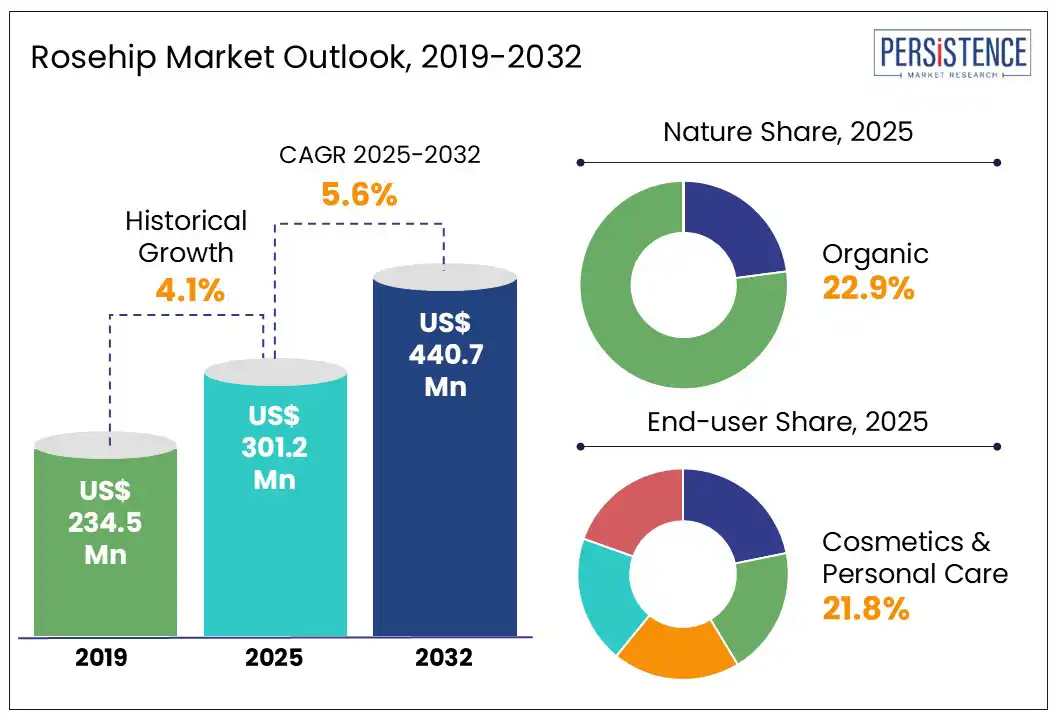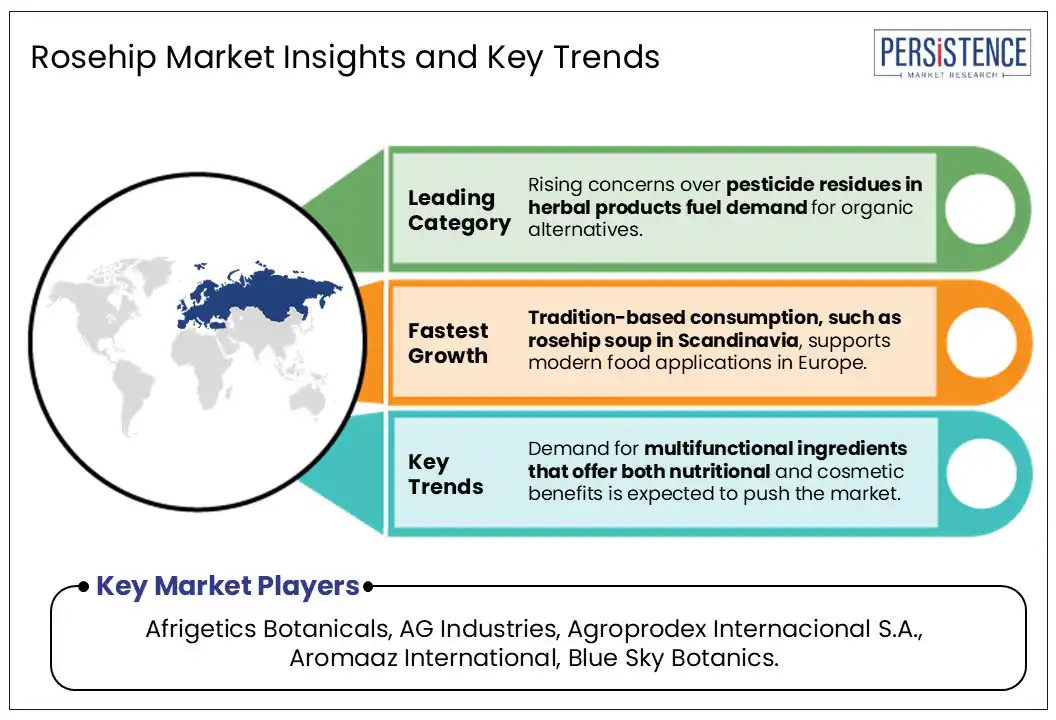ID: PMRREP33299| 182 Pages | 7 Aug 2025 | Format: PDF, Excel, PPT* | Food and Beverages

The global rosehip market size is projected to rise from US$ 301.2 Mn in 2025 to US$ 440.7 Mn by 2032. It is anticipated to witness a CAGR of 5.6% during the forecast period from 2025 to 2032. Rising demand for natural and organic ingredients in skincare, supplements, and wellness products, supported by increasing consumer health awareness and e-commerce expansion drives the market growth.
Rosehip, a once-overlooked wild berry, is now a thriving segment in the functional food, cosmetic, and pharmaceutical industries. Rich in vitamin C, antioxidants, and anti-inflammatory properties, the tiny fruit has emerged as a potential ingredient of herbal beverages, skincare serums, and supplements for joint health. The global market is expanding steadily due to rising consumer awareness of its health benefits, drawing large-scale players and product innovations.

Key Industry Highlights
|
Global Market Attribute |
Key Insights |
|
Rosehip Market Size (2025E) |
US$ 301.2 Mn |
|
Market Value Forecast (2032F) |
US$ 440.7 Mn |
|
Projected Growth (CAGR 2025 to 2032) |
5.6% |
|
Historical Market Growth (CAGR 2019 to 2024) |
4.1% |
Rosehips are expected to witness rising adoption in dietary supplements in the coming years, due to their expanding commercial production, scientifically proven health benefits, and increasing shift of consumers toward organic ingredients. Clinical studies have demonstrated the effectiveness of rosehip-based formulations in treating chronic illnesses such as obesity and osteoarthritis, compared to generic herbal supplements.
For instance, a meta-analysis of three randomized controlled studies that included 287 patients with osteoarthritis over a median duration of three months found that standardized rosehip powder significantly decreased pain levels. In addition, patients were twice as likely to respond to treatment as those who received a placebo. The demand for rosehip supplements in the joint health segment is projected to rise due to these findings. These have established the fruit as a promising plant-based substitute for traditional anti-inflammatory medications.
Digestive upset and allergic reactions are emerging as subtle but notable deterrents to the rosehip market growth. In recent clinical reviews, gastrointestinal issues such as nausea, bloating, and diarrhea have been reported in some individuals consuming rosehip in high doses. This is especially relevant in markets such as the U.S. and Germany, where rosehip supplements are marketed for daily joint health.
Allergic reactions, while relatively rare, have also been flagged, particularly among individuals with known sensitivities to plants in the Rosaceae family. Skincare products that incorporated unrefined rosehip oil, particularly those sourced from wild-harvested varieties, have been linked to contact dermatitis and itching in consumer reports. In 2022, Japan’s Consumer Affairs Agency issued an advisory after receiving over 20 consumer complaints tied to allergic reactions from rosehip-containing beauty oils and herbal teas. It prompted several brands to voluntarily update their product labels to include allergen warnings.
The growing Do-It-Yourself (DIY) wellness and skincare trend presents a significant opportunity for rosehip-based products designed for at-home use. By providing DIY kits, bulk ingredients, and home remedy solutions, companies can tap into consumer demand for natural, chemical-free options. The market is further strengthened by the shift toward sustainable living and holistic self-care, which makes rosehip an ideal ingredient for at-home formulations.
Brands are also anticipated to launch rosehip-based tea kits infused with dried rosehip pieces, echinacea, elderberry, and hibiscus. They are predicted to target calming night-time teas by mixing rosehip with lavender and chamomile. They are further anticipated to provide cold and flu relief blends as well as digestion and detox support teas. Offering such DIY rosehip tea infusion kits is expected to enable consumers to make their mixes at home.
By nature, the market is bifurcated into organic and conventional. Out of these, the organic segment is projected to account for nearly 22.9% of market share in 2025, due to increasing consumer scrutiny around pesticide residues, ethical sourcing, and nutrient integrity. The trend is most pronounced in segments such as skincare and supplements, where product purity directly influences purchasing decisions. Certifications, including USDA Organic, EU Organic, and COSMOS Organic, play a key role in shaping brand loyalty and pricing power.
Conventional rosehip is seeing decent growth due to its cost-effectiveness, stable supply chain, and scalability. It enables brands to maintain competitive pricing in price-sensitive markets such as Southeast Asia, Latin America, and parts of Eastern Europe. For example, in India, rosehip-infused teas and skin oils by domestic brands primarily use conventionally sourced rosehip to keep prices relatively low, spurring widespread accessibility and volume-driven sales.
Based on end-user, the market is segregated into food and beverages, dietary supplements, cosmetics & personal care, and retail/household. Among these, the cosmetics & personal care segment is poised to hold about 21.8% of share in 2025, due to rosehip’s proven efficacy in addressing skin concerns such as hyperpigmentation, scarring, and premature aging. Rich in trans-retinoic acid, rosehip oil is increasingly marketed as a gentler substitute for retinol. The surge of minimalist skincare and single-ingredient trends has also fueled interest in cold-pressed, unrefined rosehip oil.
Rosehip is further gaining popularity in food and beverages due to its natural vitamin C concentration, tart flavor profile, and functional positioning as an immunity-boosting ingredient. As consumers increasingly seek alternatives to synthetic additives, rosehip has emerged as a clean-label solution. Rosehip’s reddish hue and tartness are being used in artisanal jams, yogurts, and vegan desserts, where it adds both nutritional and aesthetic value.

North America is projected to witness a CAGR of 6.8% from 2025 to 2032 due to high demand for clean-label, plant-based ingredients in the wellness and beauty sectors. The U.S. rosehip market is leading in terms of consumption, with rosehip products gaining traction in dietary supplements, skincare, and herbal teas. The skincare segment is particularly dynamic, with rosehip oil being positioned as a natural alternative to synthetic retinol.
U.S.-based brands such as Radha Beauty and Kate Blanc have seen their cold-pressed rosehip oils consistently rank on Amazon, with thousands of reviews emphasizing benefits such as scar reduction and improved skin tone. Additionally, Canada-based The Ordinary, under parent company DECIEM, has experienced steady sales growth in North America with its pure rosehip seed oil. This is attributed to the product’s affordability and minimalist ingredient list that caters to Gen Z preferences.
In Europe, rosehip holds a strong position both as a traditional herbal remedy and as a functional ingredient in modern wellness products. The region is projected to account for approximately 30.2% of the rosehip market share in 2025, owing to the presence of a well-established wild rosehip supply chain, specifically in Bulgaria, Romania, and Serbia. According to Eurostat data from 2023, Bulgaria alone exported over 2,500 metric tons of rosehip and related botanical products.
Demand is particularly high in Germany and the Nordic countries, where rosehip is integrated into both nutraceutical and food applications. For instance, rosehip powder is widely consumed in Sweden as part of a breakfast staple called nyponsoppa, a traditional rosehip soup. On the supplement side, Germany has seen increased penetration of rosehip-based joint care products. In the cosmetics sector, rosehip oil is being positioned as a sustainable and traceable ingredient in organic skincare.
The growth in Asia Pacific is pushed by the convergence of traditional herbal knowledge and rising demand for clean-label beauty and wellness products. Japan, South Korea, and China are the key markets where rosehip is gaining traction, particularly in the form of seed oil, tea, and powdered supplements. South Korea’s K-beauty industry has played a key role in popularizing rosehip oil as a multifunctional ingredient. Brands such as Aromatica and Innisfree are integrating it into facial serums and moisturizers.
China’s functional food and nutraceutical sectors have also embraced rosehip, primarily for its vitamin C content and anti-inflammatory properties. According to Alibaba’s 2023 health food trend report, searches for rosehip powder and rosehip vitamin supplements grew by over 18% year-over-year on platforms such as Tmall and JD.com. Domestic brands are blending rosehip with collagen, goji berries, and hyaluronic acid to cater to female consumers in the 25 to 45 age bracket who prioritize beauty-from-within formulations.
The global rosehip market consists of various regional specialty producers, global nutraceutical companies, and cosmetic brands leveraging the fruit’s multi-functional appeal. Bulgaria, Romania, and Poland have emerged as leading suppliers due to favorable growing conditions and traditional use, often exporting to Western Europe and Asia Pacific. In these countries, small- to mid-sized producers focus on organic and wild-harvested rosehip, targeting the clean-label and premium markets. Large nutraceutical companies incorporate rosehip into joint health and vitamin C supplements, where competition is propelled by formulation innovation.
The rosehip market is projected to reach US$ 301.2 Mn in 2025.
Growth in herbal remedies and increasing use of rosehip in joint care supplements are the key market drivers.
The rosehip market is poised to witness a CAGR of 5.6% from 2025 to 2032.
Use of rosehip seed oil in gender-neutral personal care ranges and brand collaborations with herbalists are the key market opportunities.
Afrigetics Botanicals, AG Industries, and Agroprodex Internacional S.A. are a few key market players.
|
Report Attribute |
Details |
|
Historical Data/Actuals |
2019 - 2024 |
|
Forecast Period |
2025 - 2032 |
|
Market Analysis |
Value: US$ Mn |
|
Geographical Coverage |
|
|
Segmental Coverage |
|
|
Competitive Analysis |
|
|
Report Highlights |
|
|
Customization and Pricing |
Available upon request |
By Product Type
By Nature
By End-user
By Region
Delivery Timelines
For more information on this report and its delivery timelines please get in touch with our sales team.
About Author